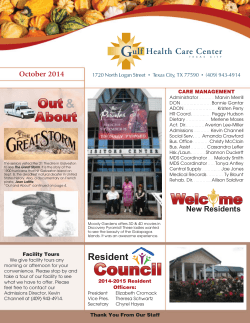
A health and wellbeing survey in North Somerset to
A health and wellbeing survey in North Somerset to investigate health behaviours and mental wellbeing Jonathan Roberts Consultant in Public Health North Somerset Council Overview • • • • Why we conducted the survey Methods Results How we are using findings Health inequalities in North Somerset • North Somerset ranks 7th in the Country for the largest inequality gap in terms of range in deprivation scores between areas. • Super output areas in the least and most affluent 1% nationally • The current slope of inequality in the gap in life expectancy between the most affluent and most deprived deciles 9.9 years for men and for 6.7 years women • Gap in life expectancy between most affluent and least wards 18 years Why did we do the research? Aim: Identify the relationship between health/wellbeing and deprivation, as well as other demographic factors to inform policy and interventions and establish a baseline to measure impact of public health activity. The survey covered the following key issues: • • • • • • • Diet and nutrition Smoking prevalence Alcohol in-take Levels of physical activity Mental wellbeing Loneliness/isolation Perceptions of trust Method • Self completion postal and on-line survey, including a reminder to nonrespondents • Targeted at four wards which represented deprived and affluent wards in North Somerset • • • • Nailsea East Blagdon and Churchill Weston-super-Mare South Weston-super-Mare Central • Random sample of addresses selected using the Land and Property Gazetteer • The questionnaire was designed to be as comparable as possible with available local and national indicators Analysis • Results weighted to ensure demographics in each ward in line with latest population data • Each health and wellbeing question analysed against key demographic variables to identify any relevant patterns • Trends, similarities or differences by different types of respondents analysed • Looked at relationships between health behaviours and mental wellbeing and loneliness Results • In total, across the four wards, 4,137 households were selected with 1,729 responding • Response rate of 42% and an overall sample error of no more than +/-2.3% at a 95% confidence level • Key findings across all areas.... – Men – Younger residents – Disabled residents – People living alone – People who are unemployed Results • Next section summarises affluent vs. deprived wards for the following: • Health behaviours (incl. combinations) – Smoking – Alcohol consumption – Diet – Physical activity • Mental wellbeing – Overall – Loneliness – Trust in others Residents in deprived areas are more likely to smoke Number of respondents: 1712 Residents in deprived areas are more likely to be heavier drinkers Numbers in brackets are the number of respondents to each question (excludes non-drinkers) Residents in deprived areas are more likely to have poor nutritional habits Numbers in brackets are the number of respondents to each question Residents in deprived areas tend to do less physical activity Numbers in brackets are the number of respondents to each question Residents that smoke are less likely to drink, but those that drink are more likely to be heavy drinkers Numbers in brackets are the number of respondents to each question Residents with poor diets and residents that do not exercise are more likely to smoke Number of respondents: Diet (1703) / Physical activity (1629) Residents with poor diets are less likely to do physical exercise Number of respondents: 1635 Residents living in deprived areas tend to have slightly lower levels of mental wellbeing Residents living in deprived areas are more likely to be lonely Number of respondents: 1699 (average across all indicators) Residents living in deprived areas are less likely to trust other people Number of respondents: 1720 According to respondents – health behaviours and social factors important Local action – using the evidence • Identified areas of higher need – reinforce health inequalities messages • Weston-super-Mare South ward asset based community development project – Funding for community builders, multi agency input • Clustering of risk factors – ‘make every contact count’ initiative • Public mental health strategy for North Somerset – Evidence for evaluation Local action – using the evidence • Loneliness – Community Connect, multi agency conference • Men’s health – Needs assessment • Workplace health and (un)employment – Workplace charter, shared work Acknowledgements • Helen Yeo, Emily van de Venter, Sandra Shcherba, North Somerset Council Public Health • Mark Yeadon, Public Perspectives Questions? Jonathan.Roberts@n-somerset.gov.uk Survey results available from North Somerset Council JSNA page
© Copyright 2025










